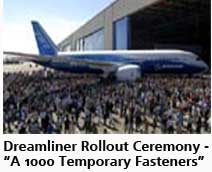For Want of a Bolt
Problems in the schedule were first acknowledged early in 2007, when delays in the supply of a variety of bolts, usually called fasteners in the industry, were cited by a variety of company sources and then finally CEO Jim McNerney as causing schedule problems.
Some say the main issue has been with a division of Alcoa that produces airline fasteners, which must meet exacting specifications. Others note that the commercial aerospace supply market, in general, was caught short after the terrorist attacks of 9/11, not expecting the tremendous surge in aircraft sales and, as a result, being slow to add capacity to meet the demand.
When Boeing unveiled the new 787 in a roll-out ceremony in July, the plane was assembled with 1000 temporary fasteners that ultimately had to be replaced with production grade product.
"We have a lot of temporary fasteners in that first airplane, that are now being reworked," McNerney said at the time. "The supply chain is just gradually catching up."
 Outsourcing by the Outsourcers Outsourcing by the Outsourcers
Boeing may not have completely understood what it was unleashing when it developed its outsourced supply chain strategy. As the Wall Street Journal reported in a recent story, in many cases, the primary suppliers were themselves outsourcing pieces of the design or manufacturer to other companies – with the same second tier firm sometimes taking business from multiple first tier suppliers.
The result: a lack of visibility by Boeing into what was really happening in its supply chain and, in some cases, supplier’s taking on more work than they could fulfill.
"In addition to oversight, you need insight into what's actually going on in those factories," Scott Carson, the president of Boeing's Commercial Airplanes unit, recently said. "Had we had adequate insight, we could have helped our suppliers understand the challenges."
Some suppliers had to build huge new factory spaces to manage the volumes, the size of the sub-assemblies, or new manufacturing processes, such as oven-treating, that Boeing used to do in the past. All these changes also contributed to challenges in meeting supply schedules. In some cases, the suppliers say Boeing itself was months late with specifications.
Nevertheless, at a recent speech, original 787 program manager Mike Bair, who has been replaced by Boeing but still remains at the company in another capacity, pointed the finger at suppliers, saying, "Some of these guys we won't use again.”
Scott Hamilton, an aerospace industry analyst, found that quote somewhat surprising.
“It's remarkable that Boeing is saying publicly that some of their world partners are falling down on the job and that Boeing made a mistake and that they will do it differently the next time,'' he said.
Bair further said in the speech that for Boeing's next all-new jet program after the 787, it would be better to have a central manufacturing site rather than the global assembly method that is being used for the 787. He said Boeing would put pressure on its suppliers the next time to locate in the Seattle area.
Whether this represents the official company view is not clear.
"Now Boeing is hostage to the suppliers, and there's very little they can do about it," says Tom Wroblewski, president of the local union for the International Association of Machinists and Aerospace Workers. The union vigorously opposed the level of outsourcing.
Buckets of Bolts
For the July roll-out ceremony, Boeing had to do more than just use temporary fasteners. When the major sub-assemblies for the fuselage sections were uncrated, Boeing mechanics found containers “filled with thousands of brackets, clips, wires and other items that already should have been installed. In some cases, officials say, components came with no paperwork at all, or assembly instructions written in Italian, requiring translation,” according to the Wall Street Journal story.
Boeing recently said that while there have been delays in test flights and the planned first customer shipment, its overall production schedule remains on track.
Pat Shanahan, who replaced Bair as manager of the program, said last week he has reorganized production and development departments for the 787 so production can be increased, and that delivery schedules for 2008 and 2009 will be met. Many industry analysts think that is far too optimistic a view.
In any case, much of the initially expected cost savings are evaporating as a result of the snafus. Boeing has announced it has set aside $2 billion to cover the costs of helping suppliers and expediting the schedule.
What is your take on Boeing supply chain struggles? Was it too much outsourcing too soon? What could it have done better? Let us know your thoughts at the feedback button below. |